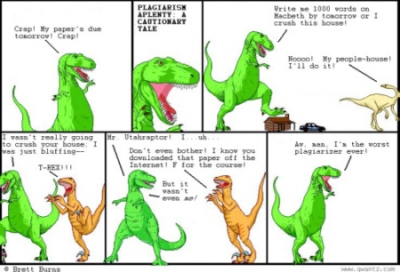WHAT IS PLAGIARISM?
Plagiarism is presenting someone else’s words or ideas as your own. The following are all examples of plagiarism:
- Quoting or paraphrasing material without citing the source of that material. Sources can include Web sites, magazines, newspapers, textbooks, journals, TV and radio programs, movies and videos, photographs and drawings, charts and graphs; any information or ideas that are not your own.
- Quoting a source without using quotation marks — even if you do cite it.
- Buying a paper online or downloading a paper from a free site.
- Copying or using work done by another student.
- Citing sources you didn’t use.
- Turning in the same paper for more than one class without the permission of both teachers.
NOTE TAKING
The best way to avoid plagiarism is to take careful notes. When taking notes, always do the following:
- First, read the entire text and summarize it in your own words. Then paraphrase important points and copy usable quotes. Enclose quotes in quotation marks.
- Carefully distinguish between material that is quoted, material that is paraphrased, material that is summarized, and your own words and ideas. Consider using different colored ink for each type of source.
- Include in your notes all the information you will need to cite your sources.
- Copy all source information into your working bibliography using the format your teacher has provided.
- Print any Web pages you use. Write the URL and the date on the Web page if it isn’t included on the printout.
- Save all your notes and printouts until you receive your final grade.
CITING SOURCES
You must cite the source of every quote, every paraphrased passage, and every summarized idea you use in a research paper. Commonly known facts, such as dates or definitions, do not need to be cited unless you take those facts directly from a specific reference source, such as an encyclopedia. If you’re not sure whether a source should be cited, include it just in case.
Sources must be cited both in the body of the paper and in the bibliography. In the body of the paper, you must do the following:
- Copy quoted material exactly, enclose it in quotations marks, and name the author immediately before or after the quote. Use the same procedure for summarized or paraphrased material, but omit the quotation marks.
- Cite the source information (title, publisher, date, and so on) for the quote or paraphrased or summarized information either in parentheses within the text or in a footnote.
- List on a reference page at the end of your paper the information for all the sources you have cited. (This is not the same as the bibliography.)
The bibliography is a list of all the sources you used — both those you cited and those you used for research, but did not cite directly. The bibliography should follow the format your teacher has provided.
WRITING THE PAPER
The following tips on the writing process also will help you avoid plagiarism.
- Read your notes carefully and make sure you understand the material before you begin to write.
- Write a preliminary draft without looking at your notes. Leave spaces where you think you’ll want to include quotes or supporting material.
- Use your own words as much as possible. No one expects you to write like an expert or a professional writer. You should, however, write like a serious, intelligent student.
- Cite all sources as you write your rough draft.
- Read through your final draft and make sure all uncited ideas are your own.
© 2002 by Education World®. Education World grants educators permission to reproduce this page for classroom use.
|






Yee Piao
March 1, 2007 at 3:26 pm
Emergence of sites like Wikipedia, Answers.com, Free Dictionary and the best of all, Google had made this kind of hassle for teachers and lecturers.
Try visiting computer labs and libraries which are full of students and you will find many printing out stuffs from these sites. Whether they will further extract it or not, we really don’t know…
ninglun
March 1, 2007 at 9:18 pm
It isn’t new, Yee Piao. I confess to copying stuff from books way back in 1955 to do some “project” or other, History I think. I wasn’t alone and the teacher didn’t really care.
The downside is, as I have told many students over the years, that you don’t learn much unless the information has actually passed through your brain in some way; otherwise you are just a human photocopier.
There are fascinating cross-cultural issues too on what “originality” actually is and whether it should even be valued as much as it tends to be in the West, but even there too much originality (not taking the accepted line on a topic for example) may count against you, no matter that teachers may deny this. Very often what teachers really want is assimilated reproduction of a particular range of ideas held to be “relevant”. It really is not so simple.
However, if you wish to pass a course you work out what the rules are and then play by the rules, and a good teacher makes the rules explicit.
I think those internet resources you mention are wonderful. I couldn’t write my blogs without them nowadays. They often help me track down things I have forgotten, or find new things. It remains true though that the most substantial knowledge is in books, which are most conveniently read in hard copy which never crashes and requires only enough light from whatever source available and a good set of eyes, and of course the ability to read.
Plagiarism, however, stops a student from reading properly, that is, critically. So there’s a lot wrong with plagiarism, and education authorities (like our NSW Board of Studies) are right to discourage it.